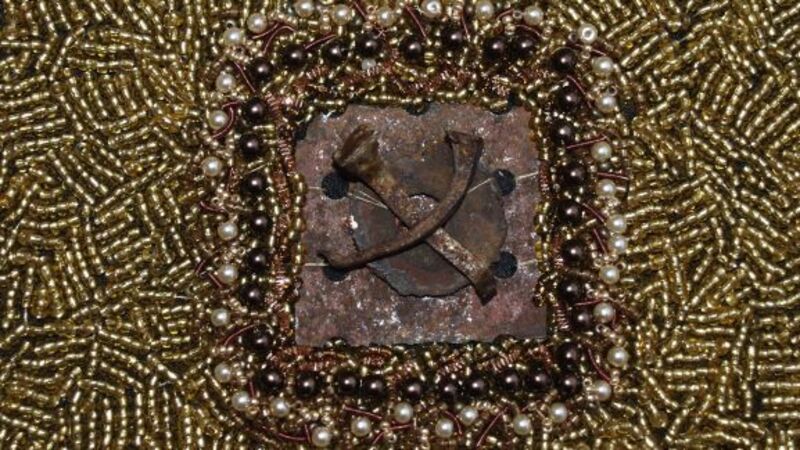The cloths of heaven

ARTIST Patricia Looby’s new show, Between a Thimble and a Nail, in Triskel Christchurch, Cork, is mixed-media, combining found objects with intricately hand-beaded fine fabrics.
A Tipperary woman, Looby attended the Crawford College of Art & Design in Cork in the late 1970s before returning to Fethard in 1993. Her art is exhibited internationally, and she teaches part-time.
Looby has a special relationship with Triskel Arts Centre, having been one of the three artists featured in its inaugural exhibition, at its Tobin Street premises, in 1985. She exhibited again there in 1990, and last year was commissioned by the director, Tony Sheehan, to develop the current show Between a Thimble and a Nail.
“I’ve been working on the show for the last year,” says Looby. “The work came about with the space in mind. I started last August and I’ve been down to visit the space a few times. I like sanctuary and treasury spaces beside cathedrals and churches.”
An interest in relics and reliquaries inspired Looby to create this body of work. Griffin Murray, from Kerry County Museum, was invited to write an essay for the exhibition to provide an insight into relics.
Looby has researched numerous Continental relics, as well as those housed in the National Museum of Ireland and the British Museum.
“Last summer, in the British Museum, there was a great exhibition on relics that I specifically went to see,” says Looby. “The reliquary actually becomes a piece of art.
“The reliquary is the object that houses the relic. In a lot of European reliquaries, they use saints’ body parts — corporeal remains, like the tongue of St Anthony of Padua. In the Irish and Scottish relics, they use more objects that would have had an association with the saints — not their actual body parts. St Patrick’s Bell Shrine would have been a big thing.”
The veneration of objects through religion is referenced by Looby in her transformation of beautiful rusted metals into things of bigger significance. The process has led her to consider her formative environment: growing up on a rural farm, outdoors was unruly, while indoors was orderly
“I’ve always liked objects and I’ve been collecting them for years,” says Looby. “I have a stall at the local car-boot sale and I’d collect things a lot at that. Wrenches, and bits of things that people would find in their sheds, but they mightn’t use anymore.
“I was brought up on a farm and I was attracted to the tools out in the shed, and bits of broken farm instruments and little bits of rust that might fall off machines and things.
“It was such a contrast to what was inside the house, to my mother and the domesticity. The farm machinery wouldn’t be something I could operate, but my mother would have taught me to operate a sewing machine and the needle was like a tool to use.”
Looby has let the object dictate the shape of things to come in the making of her work. This has resulted in groupings of objects because they demanded different treatments in their embellishment.
“It was very intuitive or instinctive really,” says Looby. “When I began working first, I did very tentative little pieces. Originally, when I started, I wanted to cut up lots of lace, but I couldn’t actually do it as it was handmade lace and I felt bad about cutting it up. Then, I started using beads and fragmented beading around an object.
“Then, they began getting bigger — in the middle of it, there were bigger objects and as I began working, the surrounding areas also became bigger. Then, later on, I’d lay out a few objects on the same piece of silk and so the object came first and the beading grew around it, according to the shape.
“Colour was also dictated by my thinking about things such as Siennese churches. I like Siennese painters and their use of the dull golds and pinks, and those kind of colours.”
Looby doesn’t strive for autobiography in her work, but the consideration of home has come through nonetheless.
“You do things that are close to you or you are familiar with,” says Looby. “You develop a lexicon, like words. They’re part of your identity, they’re part of your visual landscape, they’re personal. A personal visual landscape. I want to make a consciousness about being inside the house and when you go outside the house.”
* Between a Thimble and a Nail runs at Triskel Christchurch, Cork, until Sept 30












